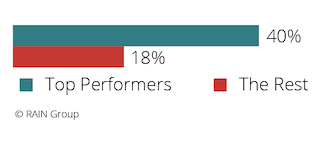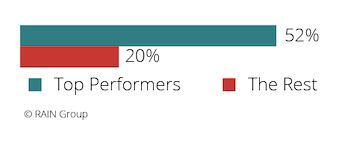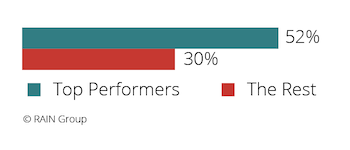You risk losing your margin, or even the whole sale, in negotiations. Final agreements are often subject to changes or budget restrictions at the 11th hour.
No wonder many sellers approach negotiations with trepidation. In fact, many research studies show anxiety is the most common emotion associated with negotiation, and our field work confirms that anxious negotiators don’t perform well.
To make things even more challenging, negotiation is different today than a decade ago:
- Procurement is more involved
- Buyers of all types have more information about you, your offerings, your competitors, and your prices
- Third parties often sit between buyer and seller (representing and insulating buyers from sellers)
- Procurement technologies are often the norm
This might make you, the seller, think the buyer has all the leverage.
Not so.
In fact, a Harvard Business Review negotiation article opens with the following, “In many industries the balance of power has dramatically shifted from buyers to suppliers.”
In most cases, a sales negotiation is critical to the success and failure of both the seller and buyer. To handle negotiations that result in the best possible agreements, sellers (and buyers) need to be skilled and know how to respond to the other party regardless of what’s thrown at them.
How Can You Be Successful in Sales Negotiations?
What Sales Negotiation Research Reveals
RAIN Group’s global research on Top Performance in Sales Negotiation reveals there’s a reason you want your sales team comprised of top-performing negotiators.
Negotiation Outcome Satisfaction and Target Pricing
The best sales negotiators are 12.5x more likely to be happy with the outcome of their negotiations and 3.1x more likely to achieve target pricing. They're also more likely to win the sale. When you consider both the increase in closed deals and higher margins, there's a massive difference in revenue generation between top negotiators and others.
But before I share the strategies you can use to become a top-performing negotiator, let’s first understand what a sales negotiation is.
What Is Sales Negotiation?
A sales negotiation is a conversation between buyer and seller working together to achieve the best possible agreement. Trades, concessions, and compromises are all common parts of a negotiation.
Negotiations most often occur toward the end of the sales cycle, when the buyer and seller are discussing specifics of the seller’s offering. They focus on price, scope, timeline, and other details. If there are any unresolved objections or concerns from the buyer, it’s up to the seller to address them.
Sales negotiations are a collaborative process. However, buyers may use negotiations as an opportunity to push for the seller to drop price or secure other concessions. In these cases, sellers must be prepared to respond to common tactics and avoid caving on price as a first response.
Notice this definition doesn’t say reaching agreement. It’s working together to achieve the best possible agreement.
If you think about negotiation as reaching agreement, you’ll put yourself at a disadvantage right from the beginning. If you feel you must make an agreement, you have no leverage, and this can affect how you act and behave in conversations. You should always know you have alternatives.
The most common alternative for a seller is simply not coming to agreement, not making the sale, and moving on to the next opportunity. Taking this mindset is empowering and helps retain your leverage with buyers.
Key Skills for Sales Negotiation
- Communications: Active listening, composure, and clear responses all play a role in navigating negotiations.
- Research: Come to negotiations prepared with thorough information on your own offerings as well as the buyer, their industry, and their needs.
- Value-Building: Analyze the negotiated issue, problem-solve in the moment, and focus on value over price.
- Objection Handling: Understand common buyer objections and turn them into opportunities to uncover needs and pain points.
- Emotional Intelligence: Manage your own emotions and those of the buyer.
6 Sales Negotiation Strategies
It’s easy to see the mistakes sellers make in negotiations, but more challenging to identify strategies they should proactively adopt.
That’s why, after two decades observing, researching, and analyzing sales negotiations, and training and coaching sellers to improve their negotiation skills, we distilled the common strategies used by the best sales negotiators into the 6 Essential Rules of Sales Negotiation.
1. Always Be Willing to Walk
Why is this first? Your mindset is critically important when it comes to negotiating. If a buyer knows you need a sale, they have leverage. At that point, can squeeze you until there's little value in a sale for you.
But if you're willing to walk and a buyer knows it, you start on a more level playing field.
Remind yourself you have alternatives and that your time is important. If you're getting pressed, communicate to the buyer that you'd look forward to working with them, but you don't need to.
Research shows that being willing to walk is the #1 strategy most separating top-performing sales negotiators from the rest, and it’s a strategy that delivers many benefits:
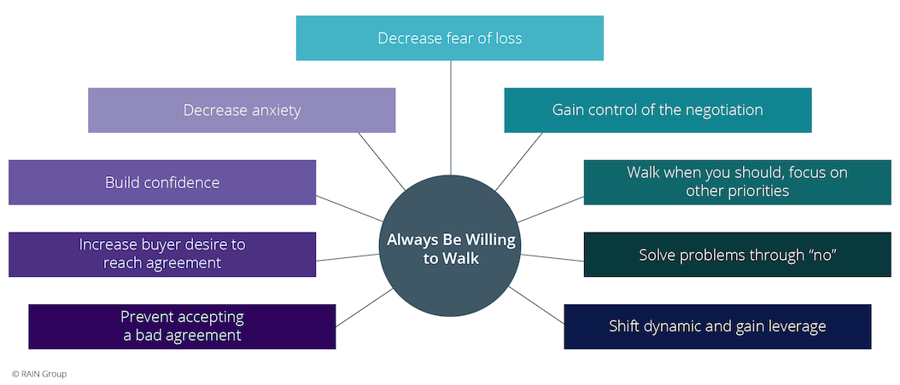
Remember: it's always okay to want the sale, but never okay to need it.
You also need to know when to walk. Many sellers don't analyze their reservation price or BATNA (best alternative to a negotiated agreement), so they end up accepting pricing and agreements that hurt them. If you know when to walk, you can walk when you should.
2. Build Value
Faced with any kind of challenge or pressed on price, too many sellers are tempted to cave. However, objections—whether price, trust, urgency, competitive challenges, or anything—can be met with problem solving and new ideas.
If you focus on the objectives, and helping you and your buyers meet them, you can almost always come up with ideas to build value without lowering the price.
For example, a buyer may raise a price objection or suggest cutting a part of the proposed solution to keep costs down. Rather than responding to a price objection by asking what price they’d prefer, focus on understanding why the buyer is pushing back.
Percentage of Sellers that Articulated Differences in Value
Is it a budget or availability of funds issue? Is it that the buyer doesn't see the value? Perhaps the buyer is simply testing whether the seller will cave under pressure. Money objections come in six flavors. Unless you know what the buyer's objective is, you can't come up with a solution that will satisfy it.
Certainly not every sales negotiation is destined to be a collaborative win-win affair. Still, when faced with challenges or objections, try to build or add value. Our research shows value-driving sales organizations have higher win rates and are 2x more likely to capture maximum prices.
Price Capture and Win Rates Among Value-Driving Sales Organizations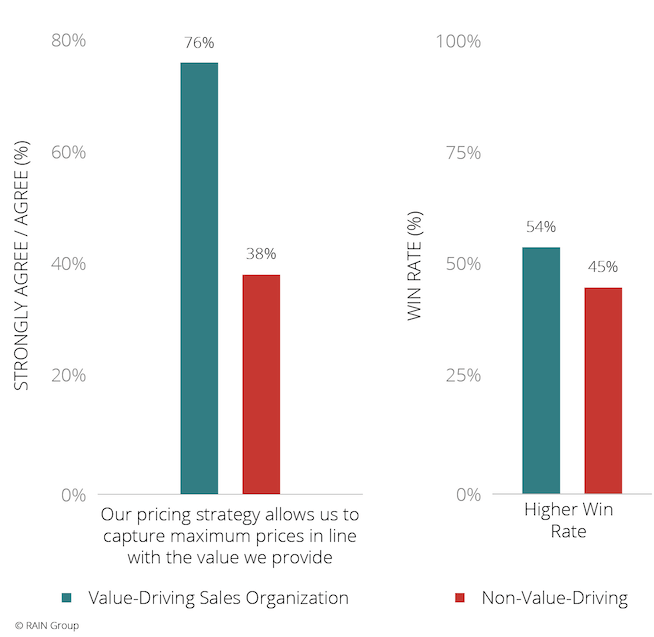
3. Lead the Negotiation
Too many sellers sit back and wait for the buyer to drive the sales negotiation. But top-performing sales negotiators are almost twice as likely to take the lead. The rest are often playing catch-up and reacting instead of leading the negotiation to a successful conclusion.
Sellers should lead. They should set the agenda for meetings, go first with offers and ideas, and go first with sharing objectives and concerns.
Sellers should also go first when sharing pricing parameters. Research shows sellers who make the opening offer are more likely to be very satisfied with the outcome of the negotiation.
Percentage of Sellers that Took the Lead in Negotiations
Indeed, too many sellers ask for budget when they should be sharing pricing proactively.
Selling means having a vision. You know what you're trying to achieve, and you work hard to achieve it. When you lead the sales negotiation, you put yourself in the best position to turn that vision into reality.
GET THE LATEST SALES TIPS, TOOLS, AND RESOURCES
Subscribe today to get the latest on virtual selling, insight selling, strategic account management, sales conversations, and more straight to your inbox.
4. Effect Emotions
Effect (verb): To bring about.
Sales negotiations are emotional affairs. They often come with anxiety, wariness, anger, and frustration. But there's also satisfaction, fulfillment, and relief.
The best sales negotiators deliberately bring about, or effect, buyer emotions. In fact, research shows Top Performers are 2.2x more likely to be prepared to manage emotions in negotiations.
Percentage of Sellers Prepared to Manage Emotions
These sellers make buyers feel respected and valued. They build rapport and make buyers feel connected to each other, building trust and negotiating in good faith. And they make buyers feel engaged in the process, so they're invested in coming to a successful agreement.
The best negotiators also control their own emotions. They manage any anger and frustration and bring about calm so they can focus. If they’re anxious or worried, they stabilize themselves before it affects their negotiations.
5. Trade, Don't Cave
Buyers will often test a seller's cave tolerance. They'll ask for a lower price, and they'll often get it. When faced with the question, "Can we do it for less?" too many sellers will say, "Where do we need to be?" and drop their price.
If you’re willing to simply drop your price, you tell buyers this is what you do. They’ll always expect concessions and be wary of negotiating with you because of the pricing games they believe you play.
The best sales negotiators are willing to explore new possibilities, adjust scope, or make a trade that could change the price. And they’re 2.6x more likely to be prepared to trade.
Percentage of Sellers Prepared with Ideas to Trade
Trading means asking for something in return when something is asked of you. It also means offering something proactively when asking for something from the buyer.
At its core, trading is about reciprocity. Mutual give and take.
Think of it this way: if you don't trade, anything the buyer asks for that you’re willing to concede must not have value. If it doesn't have value to you, don't expect the buyer to value it.
Instead of allowing the pie to shrink, the act of trading can increase value for both sides. The classic trade is where both sides concede something of lesser value to them in return for something of greater value.
This mutual gain is at the heart of collaborative negotiations. For example:
"I can offer the customer more regular deliveries to offset their warehouse space problem which is no problem as their facility is in the same industrial park as another customer. In return, they lengthen the contract to coincide with their planned factory refit."
Sellers who plan for trades, and have them ready when it's time, create better agreements and reach agreement more often.
6. Plan to Win
Preparation is a major factor in sales negotiation success. Know what you want, work to understand what the buyers want, plan your strategy, and plan for any tactics you might face. If you do so, you'll create great agreements consistently and win maximum sales at favorable terms and pricing.
Knowledge is a source of power. Lack of knowledge introduces doubt on both sides of the negotiation, which can lead to fizzled negotiations and lost sales. You can anticipate so many aspects of negotiation if you do your research and planning beforehand.
Percentage of Sellers Prepared for Negotiation
Negotiation is not an arena for improvisation. You can end up caving to buyer demands or accepting an offer not in your interest. You can end up giving the buyer pause when they question your preparedness, skill, and overall competence, casting doubt on their desire to buy from you.
With the right plan you can expand the pie, build confidence, handle challenges and issues that come up along the way, and lead the way to successful agreements for both you and the buyer.
Sales Negotiation Tips
1. Make a Plan
A plan allows you to answer critical questions that will guide the negotiation. Think of it like this: if the buyer plans and you don't, who is likely to have a better outcome? If the buyer plans and you don't, can you even lead?
When you have an important negotiation, prepare a complete negotiation plan. Use the Planning to Win Sales Negotiations checklist to make sure your plan covers all the bases.
5 Steps to Rapidly Prepare for a Negotiation
Sometimes you have a smaller negotiation, or you have only an hour to consider major issues. If you have limited time, here are 5 crucial steps to help you prepare:
- Identify your objectives and their objectives
- Brainstorm possibilities and trades
- Know your BATNA (best alternative to a negotiated agreement) and Reservation Price (the least favorable point at which one will accept a negotiated agreement)
- Decide how to open
- Analyze your leverage (e.g., how much do they want or need you?)
Never go into a negotiation unprepared!
2. Set the Agenda
A key part in leading the sales negotiation is teeing up the meeting properly with an agreed upon agenda ahead of time. When you’re the one writing the agenda, you can more effectively lead the conversation.
Here’s what a good agenda for a negotiation discussion looks like:
- Review background and objectives: The first part of the agenda should almost always be to review background and objectives. By starting with objectives, you set a tone of collaboration and can focus the buyer's attention on their goals, not their problems.
- Identify issues to be addressed: Specify all issues that need to be worked out. If you don't do this, key pain points may not be addressed, leaving room for the buyer to take control of the conversation while you appear unprepared.
- Confirm the agenda with the buyer: Once you've defined the agenda, don't assume you've covered all the bases. Email the agenda to the buyer before your meeting and request their input. This provides them with an opportunity to add, edit, or remove items. This will help them feel respected, engaged, and valued.
Here’s an example of an agenda sent via email before a meeting:
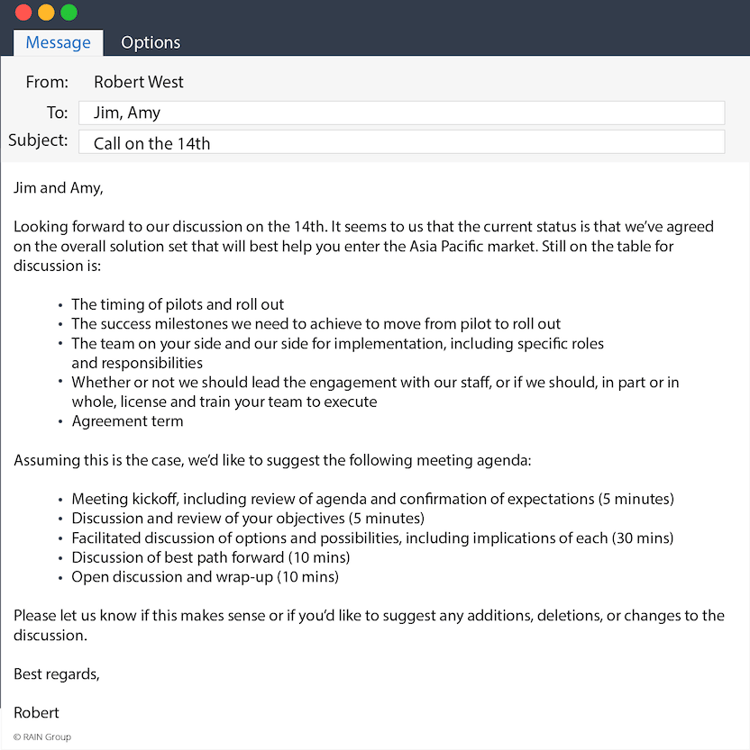
When you arrive at the meeting, open with, "Here's the agenda we set. It covers X, Y, and Z. Does this still work for everyone?"
3. Make the Opening Offer Whenever Possible
This allows you to take advantage of the anchoring effect.
Anchoring is what’s called a cognitive bias, an irrational part of human decision making. When making decisions, people strongly favor the first piece of information they see. Every evaluation afterwards is based on this information and it anchors how far their final decision can go.
Research shows that sellers very satisfied with the outcome of a negotiation are more likely to have made the opening offer.
4. Ask for Budget When It Makes Sense
You shouldn't always go first. There are situations where you might ask for a budget before making an offer, such as when you know they buy similar products/services and you're trying to displace a competitor.
5. Facilitate the Discussion and Collaborate
Avoid getting derailed. Don’t leave it to the buyer to facilitate, as they may engage in unhelpful bargaining or argue about positions on pricing and terms.
When you facilitate, you can encourage collaboration that deepens relationships and trust.
Ask questions that guide the discussion while allowing buyers to feel connected and engaged. When they come up with fruitful ideas, allow them to own those ideas so they’ll also feel respected and valued.
Discussions without a leader often run out of time. By taking control of the agenda and the meeting, you can ensure this doesn't happen. For example, you might say something like:
"Looking at the clock, we have 20 minutes left. It seems we’re feeling good about points A, B, and C, but we still really need to address D. I'd suggest we do that, assuming you all agree this is where we are. Does anybody see anything else we need to address to be able to have the right data to make a decision to go forward or not?"
If you don't take the lead, the meeting won't end with the desired outcomes.
6. Diffuse Any Tension
Sales negotiations can be stressful. Emotions run high (see strategy #4 above). Even if both parties agreed to the agenda ahead of time, don't open by jumping straight to the agenda if you sense tension in the room. Doing that can cause the buyer to remain guarded for the rest of the meeting.
Instead, lighten things up. Ask if anyone did anything fun over the weekend, give a genuine compliment, or make small talk about sports or kids. Focus on building rapport first and then address the agenda. Remember, people do business with people they like.
7. Be Prepared to Trade
To respond to buyer requests with those of your own, prepare your trading possibilities in advance. Create a trade list with value assigned to each. Be creative and exhaustive. Consider both strategic and tactical agreement components.
When trading:
- Avoid single-issue bargaining: This is "horse trading," not negotiating. Every time you make a trade offer, you don't change just one thing, you change the whole picture. Bundle issues creatively.
- Focus on objectives before trades: Make sure to engage the buyer, asking them for their ideas and zooming out to see the big picture. Think buying first, selling second. Have the buyer consider how the trade will impact their own objectives and how it meshes with their requirements.
- Pace yourself: Don't make two concessions/trades in a row. Invite response from the buyer. Don't agree too quickly. Think. Deliberate. Make sure the buyer knows you value what you give up.
- Make increasingly smaller concessions: If you must make concessions, make them increasingly smaller. This signals to the buyer that your tolerance for giving up more is wearing thin.
8. Gain Commitment
It's up to you to close the sales negotiation when it's time. I’ve seen too many sales where a verbal "yes" turns into a "no" over time because the agreement wasn't buttoned up, or it wasn't buttoned up fast enough.
To ensure the commitment you gain is durable, consider that influence researcher Robert Cialdini found verbal, written, and public commitments are much more likely to be kept than verbal or verbal and written only. With that in mind, take these 3 steps:
- At the end of negotiations, get verbal agreement. Listen and confirm that buyers are ready to move forward.
- Next, summarize what was agreed to, let buyers know you’ll write it up immediately and send it to them for confirmation, and would appreciate a "yes" reply to make sure you didn't miss anything.
-
Finally, as soon as possible, get the buyer to announce internally they’re moving forward, even if a contract hasn't been signed.
Sales Negotiation Training
Do you need sales negotiation training to be a good negotiator?
In our research, we found top-performing sales negotiators are 9.3x more likely to have received extremely effective training.
Outcomes of Negotiation Training
And 78% of sellers who participate in extremely effective training are very satisfied with the outcome of their negotiations.
Meanwhile, buyers are 1.5x more likely to have received extremely effective negotiation training compared to sellers. Without preparation, you and your team could be negotiating at a disadvantage.
This is a big deal when you consider that the effectiveness of negotiation training positively correlates with buyers receiving price concessions and discounts, achieving pricing targets, and satisfactory outcomes.
It’s a wake-up call for sellers to boost their training effectiveness to match that of buyers.
How to Master Sales Negotiation
To be a top-performing sales negotiator, you must be able to:
- Reach the best win-win solutions for your company and your customers
- Lead a masterful sales negotiation process that results in win-win solutions when possible
- Deal with common buyer tactics that drive down margins
- Strengthen relationships with customers and enhance the opportunity for future work
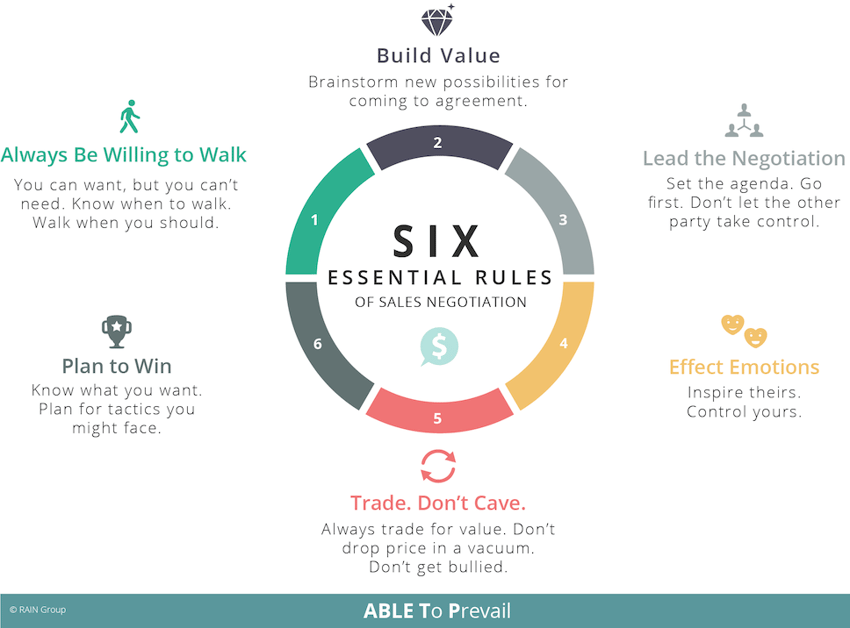
The first letter in each rule creates the acronym ABLE To Prevail. Remembering ABLE To Prevail will help you commit the 6 Essential Rules of Sales Negotiation to memory.
Using the 6 Essential Rules of Sales Negotiation, beginner sales negotiators can learn core concepts and skills they can apply immediately to increase their negotiation confidence and success. At the same time, experienced sellers and negotiators can use the model as a framework for honing their skills to improve their mastery.
Ultimately, negotiation is a massive topic, and some of it is out of your control. The buyer and the skills, training, and collaborative spirit they bring to the table can make a big difference on the outcome. But, like most things, the 80/20 rule applies: 80% of your success comes from just 20% of your input—as long as it’s the right input.
Learn the 6 Essential Rules of Sales Negotiation, and practice their application, and you’ll be on your way to mastering sales negotiation.









